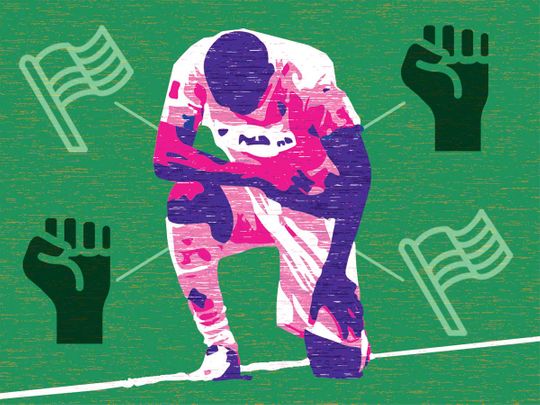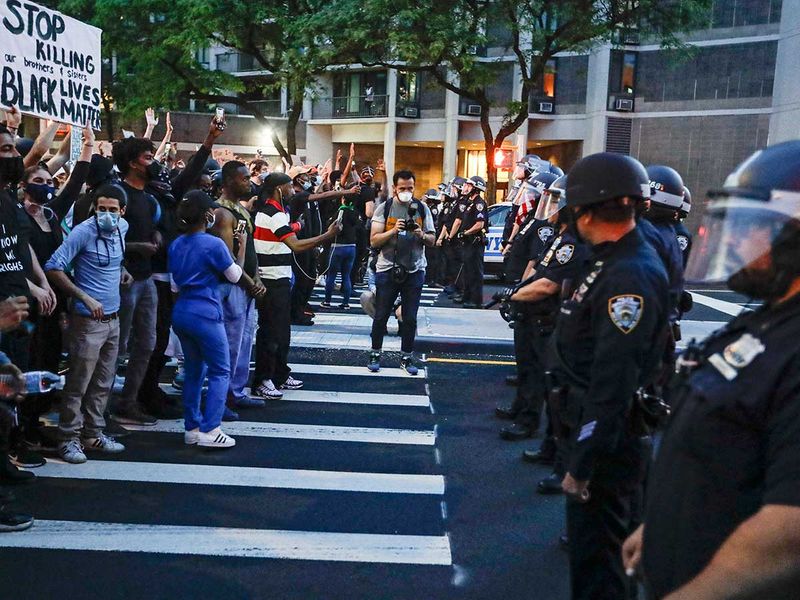
If you follow English football like me, you must have noticed recently, besides the absence of the fans in the stadiums, the kneeling of players before each game. That’s in solidarity with the ‘Black Lives Matter’ anti-racism movement, which started in the United States following the death of George Floyd at the hands of Minnesota police.
Floyd’s death, which sparked three weeks of protests in the US, led to a worldwide examination of race relations and the way minorities are being treated for centuries. That could lead, hopefully, to not only legislations to ensure justice and equality for the minorities but also to inter-race relations that are no longer dominated by colour, ethnicity or religion.
But it should all begin with the US, where African- Americans continue to suffer from bigotry, be it in their towns, in the workplace, in the courts and clearly in the police stations.
The Floyd protests affected the hearts and minds like never before. Unfortunately, and unlike in previous movements, the laws lag this time.
They say “It takes one person to rewrite the history book,” and that person happens to be George Floyd this time. Or is it the police officer who knelt on his neck leading to suffocation? I am not sure. Nonetheless, either man will have unintentionally forced America to reassess the way Blacks are treated. What we are witnessing today is a movement of historical proportions that reminds us of the original civil rights movement in the US.
That too was started by one person. A 16-year-old Black girl’s courage led to landmark changes in the laws but unfortunately failed to change the hearts and minds of many who still think on the lines of colour.
On April 23, 1951, Barbara Johns, fed up with the miserable conditions in her all-Black segregated school, organised a protest that attracted 400 of her school mates to demand better facilities. They walked out of the school, in Farmville, Virginia, and said they would boycott classes until the education board, an all-white commission, fixes the facilities. The board refused, but their case attracted the attention of a prominent civil rights lawyer who decided to address the larger problem instead of merely asking for better facilities. He sued for an end to segregation in schools altogether. The case was joined by similar cases across the US and went to the Supreme Court. The court, in 1954, issued a historic decision to outlaw segregation in schools. You might not have heard of Barbara Johns, but her courage changed America forever.
How civil rights movements spread
It galvanised civil right movements. Demonstrations to end discrimination spread all over the US. The largest was the Great March on Washington for Jobs and Freedom, August 28, 1963, which forced Democratic President John F. Kennedy to propose what became the Civil Rights Act. Kennedy was assassinated three months later. But his successor, Lyndon Johnson signed the bill on July 2, 1964.
The civil rights movement didn’t stop there. The Barbara Johns legacy continued, as African Americans ramped up their struggle to gain equal opportunities. They forced legislators and President Richard Nixon in the late 1960s to pass the Affirmative Action Act which set policies to ensure the hiring of blacks in some states. In colleges, factories and even corporate boardrooms, African Americans found opportunities to compete and contribute on an equal footing — at least in the eyes of the law.
The rise of conservative America
These successes were expected to change America. They did, partially. Many in white America didn’t approve, though. As the 1990s came, it seemed the inter-race relations were going one step forward and two steps backwards.
So, what happened? Why did it get worse? It was due to the rise of conservative America. In the midterm elections of 1994, an ultra-conservative fiery politician named Newt Gingrich led Republicans to a massive victory to take control of the Congress for the first time since 1954. Ironically, 1954 was the year Barbara Johns won the case against school segregation. Fifty years later, Gingrich and his party brought back conservatism, big time.
Liberal America has since found it difficult to come up with new ideas. Even affirmative action policies came under attack. Angry white groups, spurred by the success of conservative politics, started to appear across the country. Conservative ideas became hate speech directed at the other American. Police violence against Blacks became routine. And in 2020, George Floyd tragically came into the picture. His last words, “I can’t breathe”, as Minneapolis police officer Derek Chauvin knelt on the back of his neck for 9 minutes, became the slogan that sparked anti-racism protests that resonated beyond the US borders.

It led to a reassessment of the way America treats its Black minority, including an overdue look at the country’s biased history. Significant initiatives have taken place, which was impossible to imagine a few months ago. The famed American football club, the Washington Redskins, a national sports icon for decades, said it was changing its name and logo, long-considered offensive to native Americans. Statues of southern leaders from the Civil War era who opposed the abolition of slavery have been removed from several US cities. The state of Mississippi took a more significant step by announcing plans to change its flag, which bears the cross of the Confederate battle flag. African Americans for long walked under that flag, which represented the ‘pride’ of those who denied them their rights and dignity for centuries.
The Floyd protests affected the hearts and minds like never before. Unfortunately, and unlike in previous movements, the laws lag this time. The likes of Kennedy and Johnson are no more. The man in the White House today refuses to acknowledge the need for legislation to ensure the progress of the race relations. He is angry at the calls to re-examine parts of America’s history, which are offensive to Blacks.
Nevertheless, I think a change is coming. It took a determined young Barbara Johns to change America in the last century. I don’t think it will take that long this time. America, after Floyd, will surely never be the same.







